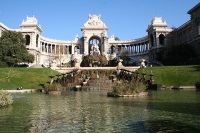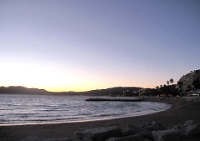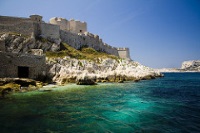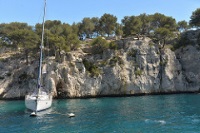Things to do in Marseille
A city that is sometimes tragically overlooked in a country so full of popular destinations, vibrant, cosmopolitan Marseille has a lot to offer tourists. It's well situated as a base for glorious excursions along the coast but there are also plenty of things to see and do in Marseille itself.
Perhaps the most famous attraction of Marseille is the imposing Château d'If, the infamous setting for Alexander Dumas's The Count of Monte Cristo. The island is just off the coast and can be quickly reached by ferry; the prison is disturbingly well preserved. Other attractions in Marseille include the Basilique de Notre Dame de la Garde, which is a magnificent cathedral with wonderful views of the city and a richly decorated interior as impressive as its facade, and the Parc Borely, a lovely open area with a botanical garden and boating lake. The ornate Palais Longchamp is also definitely worth a visit. The palace now houses the Musee des Beaux Arts and the Natural History Museum and it also features an enormous fountain and extensive grounds that are a joy to explore.
One of the most popular attractions in Marseille is the beachfront. The city has some lovely beaches, including the popular Plage des Catalans near the city centre. The corniche, or promenade, makes for a nice stroll as it winds past several beaches and inlets. Just south of Marseille are the famous Massif des Calanques, deep limestone fjords that make for a dramatic and spectacularly beautiful coastline that attracts climbers, divers and hikers. Visitors can take a boat cruise out from Marseille to explore the area and are sure to find some exceptional swimming spots. The picturesque resort town of Cassis, hemmed in by white cliffs, is also a popular excursion from Marseille.
Marseille's food scene is an absolute must for its affordable, creative and inclusive fare, which is a mix of North and West African, Asian, and French cultures. Among other dishes, discerning foodies should be on the lookout for bouillabaisse (the city's iconic fish stew), ojja merguez (a saucy Tunisian egg-tomato-sausage breakfast), and Senegalese yassa (a rich, garlicky chicken or fish topped with buttery, lemon-heavy onions).

Palais Longchamp
One of Marseille's most scenic buildings is the Palais Longchamp. Built during the Second Empire, it is the grandiose conclusion of an aqueduct that once brought water from the Dur…
Palais Longchamp
One of Marseille's most scenic buildings is the Palais Longchamp. Built during the Second Empire, it is the grandiose conclusion of an aqueduct that once brought water from the Durance to the city. Although the aqueduct is no longer in use, water is still pumped into the centre of the colonnade connecting the two palatial wings.
Below, a spectacular fountain features an enormous statue of three muscular women above four bulls wallowing in a pool from which a cascade drops four or five storeys to ground level. Marseille had a serious water problem (and attendant cholera problem) for centuries so this enormous tribute to water is historically fitting.
In the palace's north wing is the Musée des Beaux-Arts, which displays a vast array of paintings from the 16th to the 19th centuries. They include works by Corot, Millet, Ingres, David, and Rubens as well as some 80 sculptures and objets d'art; particularly interesting is a gallery of Pierre Puget sculptures. The palace also houses the Natural History Museum, and there is a small Planetarium in the vast park. It is lovely to wander or picnic in the gardens and, every year in July, the huge park is the main venue for Marseille's prestigious Five Continents Jazz Festival.
Massif des Calanques
Directly south of Marseille, and to the west of Cassis, is the wild coastline of the Massif des Calanques. Some of France's most beautiful and dramatic scenery can be found along t…
Massif des Calanques
Directly south of Marseille, and to the west of Cassis, is the wild coastline of the Massif des Calanques. Some of France's most beautiful and dramatic scenery can be found along this 12 mile (19km) stretch of coastline; the sea has cut gorges, up to a mile (2km) deep, into the limestone. Dazzling white limestone cliffs overhang the sea and attract rock climbers and deep-sea divers from all over the world. The mountains rise up 1,850 feet (564m) and are a haven for climbers.
Walking tours and boat trips to explore the area can be organised via the tourist board, and visitors don't have to be experienced climbers to enjoy walking in the area. Those taking boat rides to the Calanques from Marseille, should take one of the longer trips because the scenery only gets more dramatic and more beautiful, and most people want to spend as much time as possible exploring. Travellers can also hire private boats, which is ideal because then one can stop and swim at will.
The highlight of the Calanques is Sormiou, with its beach, seafood eateries and small harbour. Sormiou is separated from another small but enchanting settlement at Morgiou by Cap Morgiou, which offers a panoramic belvedere with splendid views of both the Calanques and the eastern side of the massif. At Morgiou there are tiny creeks that are great for swimming.

Marseille Beaches
The most popular beach in Marseille, near the city centre, is the Plage des Catalans. This marks the beginning of Marseille's corniche, which ends at the Plage du Prado, the city's…
Marseille Beaches
The most popular beach in Marseille, near the city centre, is the Plage des Catalans. This marks the beginning of Marseille's corniche, which ends at the Plage du Prado, the city's main sand beach, where the water is remarkably clean. There is a nice walk along the corniche that takes visitors past the Anse des Auffes, a picturesque inlet with small fishing boats beached on the rocks, and then behind the Plage de Prado to the Parc Borély, which has a boating lake, rose gardens, palm trees and a botanical garden.
The botanical garden is open daily from 8am to 9pm and entrance is free; a stroll here is a fun addition to promenading along the Marseille beachfront and a good chance to enjoy some shade. Along the Malmousque peninsula there are a number of tiny bays and beaches that are perfect for swimming when the mistral wind is not exciting the waves too much. The small beaches between La Pointe Rouge harbour and La Madrague harbour also tend to be clean and usually slightly less crowded than some of the more touristy beaches. There should be a beach to delight everyone in Marseille as there is quite a lot of variety and visitors can enjoy watersports, sun lounging, and fashionable strolling.
Website www.marseille-tourisme.com/en/discover-marseille/sea-and-nature/the-beaches/

Château d'If
On the sparsely vegetated island of If is the infamous prison, Château d'If, which is best known as the penal setting for Alexandre Dumas' famous book The Count of Monte Cristo. F…
Château d'If
On the sparsely vegetated island of If is the infamous prison, Château d'If, which is best known as the penal setting for Alexandre Dumas' famous book The Count of Monte Cristo. François I built the fortress here to defend Marseille and its port in the 16th century, and the site later housed a state prison that was notorious for incarcerating enemies of the royalty. The cells are horribly well-preserved; carvings by Huguenot prisoners can still be seen inside some of them. On a lighter note, the views back towards Marseille and the mountains beyond are wonderful to behold and the trip over in a boat is enjoyable. The ferry to the island will not run if the weather is bad, and opening and closing times can change in accordance with the ferry schedule.
Website if.monuments-nationaux.fr

Cassis
Cassis is a beautiful resort town just west of Marseille. Hemmed in by high white cliffs, its modern development has been carefully limited and it retains much of the charm lost by…
Cassis
Cassis is a beautiful resort town just west of Marseille. Hemmed in by high white cliffs, its modern development has been carefully limited and it retains much of the charm lost by its more high-profile neighbours. Built on the side of a hill, the old village is centred around a shady square where the inhabitants come to cool off and play 'pétanque' (a form of lawn bowling) on summer nights. Portside posing and drinking aside, there's not much to do except sunbathe and look up at the ruins of the town's medieval castle, built in 1381.
A popular excursion is to take a boat trip to the calanques (coves), which are long, narrow, deep, fjord-like inlets that have cut into the limestone cliffs. Those feeling energetic can take the well-marked footpath from the Route des Calanques behind the western beach; it's about a 90-minute walk to the furthest and best calanque, En Vau, where one can climb down rocks to the shore. Intrepid pine trees, and sunbathers, manage to find ledges on the chaotic white cliffs. The water is deep blue and swimming between the vertical cliffs is an experience not to be missed. A holiday in Cassis is peaceful and sun-drenched and the natural surroundings are truly spectacular.
Website www.ot-cassis.com/en/#home-decouvrir



